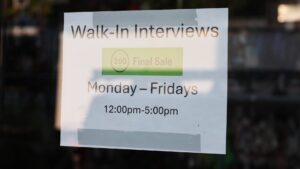The Changing Tides: Federal Reserve’s Focus Shifts from Inflation to Unemployment
The Federal Reserve has traditionally focused on controlling inflation to ensure economic stability. However, recent indicators suggest that the central bank is shifting its attention to the growing concerns surrounding unemployment. This change in focus is backed by data pointing towards a labor market that is either deteriorating or slowing down.
According to Troy Ludtka, senior U.S. economist at SMBC Nikko Securities, "Unemployment takes the stairs down and the elevator up." This analogy highlights the rapid acceleration of unemployment once it starts to rise. The latest data from The Conference Board’s monthly survey on consumer confidence paints a concerning picture of the labor market. While the headline number for August showed a slight improvement, the survey indicated a decrease in respondents who considered jobs "plentiful" and an increase in those who found employment "hard to get."
Historical trends suggest that the gap between these two indicators aligns more with an unemployment rate of 4.8%, higher than the July rate. Additionally, the Labor Department’s recent report of modest job growth in July and a significant overcount of job gains from April 2023 to March 2024 contribute to the growing concerns surrounding the labor market.
With inflation gradually easing back towards 2%, the Fed faces the challenge of balancing its dual mandate of full employment and price stability. Market expectations of an imminent rate cut reflect the urgency of the situation. Fed Chair Jerome Powell emphasized the importance of not further cooling labor market conditions in his recent speech, acknowledging the considerable decline in hiring.
As the central bank navigates these challenges, the focus on the health of the labor market will likely drive the pace of future rate cuts. While historical data suggests a steady unemployment rate through 2026, current momentum indicates a potential rise. SMBC Nikko forecasts unemployment in the mid-5% range within a year, prompting the Fed to adopt a more aggressive rate-cutting stance.
The evolving dynamics of the labor market pose a significant challenge for monetary policy makers, requiring a delicate balance between stimulating employment and achieving price stability. As the Federal Reserve adapts to these shifting dynamics, investors and market observers are keenly watching for indications of the central bank’s next move. Stay informed and stay ahead with Extreme Investor Network’s in-depth analysis and expert insights on the changing economic landscape.

